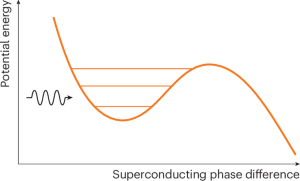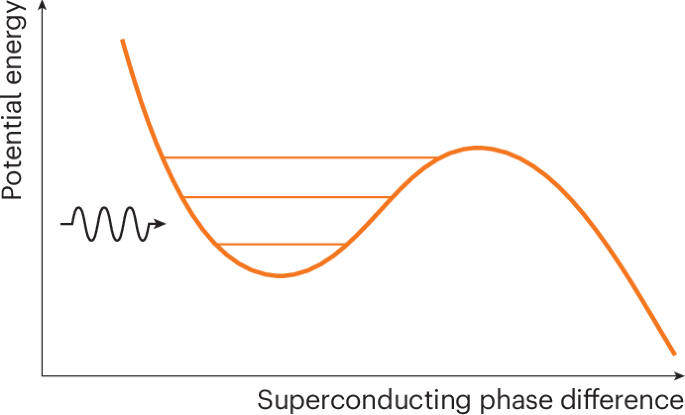The 2025 Nobel Prize in Physics has been awarded to John Clarke, Michel Devoret and John Martinis “for the discovery of macroscopic quantum mechanical tunnelling and energy quantisation in an electric circuit”.
Quantum effects are typically confined to microscopic scales, allowing for a conceptual separation between classical and quantum regimes. This neat division, however, is challenged by phases of matter such as superfluids and superconductors, where a macroscopic number of particles are in a single collective quantum state. This year’s Nobel prize in Physics recognizes joint work by John Clarke, Michel Devoret and John Martinis demonstrating that superconducting circuits can feature macroscopic quantum behaviour1.

Credit: Figure adapted with permission from ref. 1, APS
In a superconductor, electrons pair into a condensate characterized by a quantum phase — a collective degree of freedom that can vary over time and space. When two superconducting regions are separated by a thin insulating barrier, forming a Josephson junction, the phase difference between the two regions allows a current to flow across the junction without resistance. The discovery of this Josephson effect was the subject of the 1973 Nobel Prize in Physics, and it plays a central role in this year’s prize.
The dynamics of the quantum phase of a superconductor is analogous to a particle in a potential energy landscape. A Josephson junction modifies this landscape by introducing a nonlinear, oscillatory structure in the energy profile, which often gives rise to multiple metastable energy minima, such as the one shown in Fig. 1.
The multiple minima of the potential energy landscape correspond to different configurations of the macroscopic superconducting state. If the superconducting phase obeys quantum mechanics, then it should be possible to exploit these distinct configurations to observe quantum phenomena — for example, macroscopic superpositions of two different states or quantum tunnelling between minima. However, because macroscopic objects are normally subject to interactions with the environment that cause dissipation and decoherence, such phenomena are usually unobservable at this scale.
In the 1980s, theoretical analyses2,3 showed that quantum effects might indeed be observable in macroscopic systems if dissipation was sufficiently weak. They suggested that the easiest path would be to search for quantum tunnelling of the superconducting phase out of a metastable state into one with lower energy — a process involving the collective quantum state of the electrons in the superconductor. Although thermal effects can also cause the quantum phase to escape the potential well, these are suppressed at low temperatures, leaving quantum tunnelling as the dominant mechanism.
Following these theoretical predictions, several experiments on superconducting circuits with Josephson junctions reported behaviour consistent with macroscopic quantum tunnelling4. The decisive step, however, came when Clarke, Devoret and Martinis managed to determine all necessary circuit parameters through classical measurements. This allowed direct comparison between theory and experiment, and the observed tunnelling rates showed quantitative agreement with predictions without the use of any adjustable parameters.
Furthermore, the prize-winners demonstrated that the metastable potential well hosted quantized energy levels (horizontal lines in Fig. 1) associated with different quantum states of the collective phase. They used microwaves (wavy line in Fig. 1) to drive the system from one state to another, which in turn changed the observed quantum tunnelling rate.
These manipulations of the superconducting phase as a quantum degree of freedom laid the foundation for modern superconducting qubits5. In the decades since, the increasing sophistication of superconducting quantum circuits has made them leading candidates in the race to build quantum computers.
From a more fundamental perspective, the effort to observe and control macroscopic quantum phenomena continues6. Macroscopic quantum tunnelling has been observed in other systems, such as single molecule magnets7. In addition to addressing remaining questions about the divide between classical and quantum regimes8, large quantum systems also feature in proposed tests of quantum gravity9.
The key role of Josephson junctions highlights that Clarke, Devoret, and Martinis built on earlier Nobel-recognized work to achieve their breakthrough. Given how much impact their discoveries have already had on both applied and fundamental physics, it is likely that research built on their foundational contributions will lead to another prize in the future. This showcases the progress of ideas and applications in science: each generation builds on the successes of the previous one and together they move forward.

